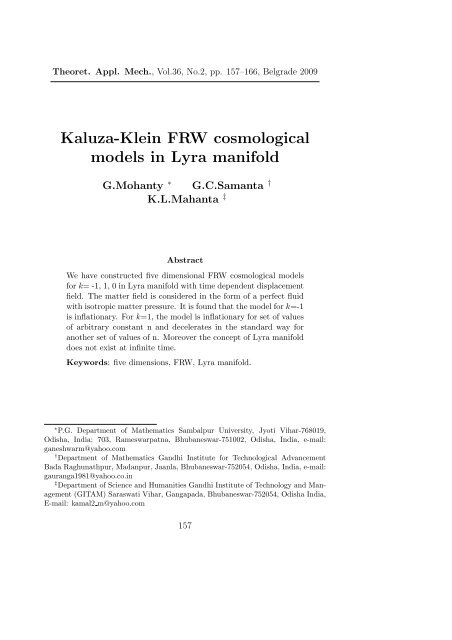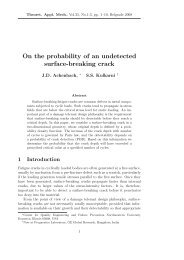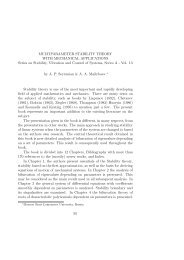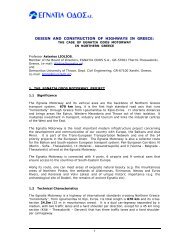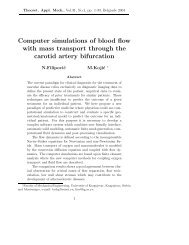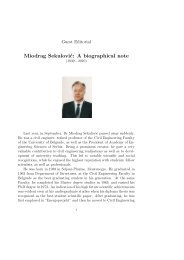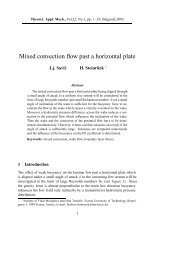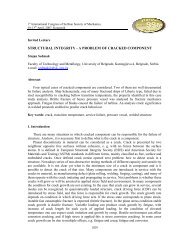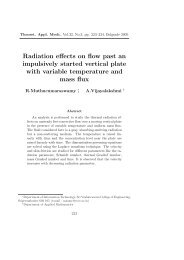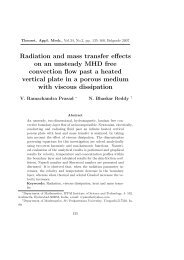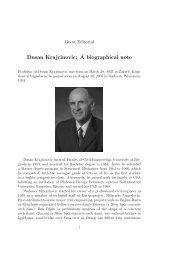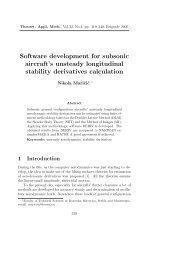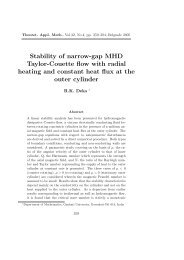Kaluza-Klein FRW cosmological models in Lyra manifold
Kaluza-Klein FRW cosmological models in Lyra manifold
Kaluza-Klein FRW cosmological models in Lyra manifold
You also want an ePaper? Increase the reach of your titles
YUMPU automatically turns print PDFs into web optimized ePapers that Google loves.
Theoret. Appl. Mech., Vol.36, No.2, pp. 157–166, Belgrade 2009<strong>Kaluza</strong>-<strong>Kle<strong>in</strong></strong> <strong>FRW</strong> <strong>cosmological</strong><strong>models</strong> <strong>in</strong> <strong>Lyra</strong> <strong>manifold</strong>G.Mohanty ∗ G.C.Samanta †K.L.Mahanta ‡AbstractWe have constructed five dimensional <strong>FRW</strong> <strong>cosmological</strong> <strong>models</strong>for k= -1, 1, 0 <strong>in</strong> <strong>Lyra</strong> <strong>manifold</strong> with time dependent displacementfield. The matter field is considered <strong>in</strong> the form of a perfect fluidwith isotropic matter pressure. It is found that the model for k=-1is <strong>in</strong>flationary. For k=1, the model is <strong>in</strong>flationary for set of valuesof arbitrary constant n and decelerates <strong>in</strong> the standard way foranother set of values of n. Moreover the concept of <strong>Lyra</strong> <strong>manifold</strong>does not exist at <strong>in</strong>f<strong>in</strong>ite time.Keywords: five dimensions, <strong>FRW</strong>, <strong>Lyra</strong> <strong>manifold</strong>.∗ P.G. Department of Mathematics Sambalpur University, Jyoti Vihar-768019,Odisha, India; 703, Rameswarpatna, Bhubaneswar-751002, Odisha, India, e-mail:ganeshwarm@yahoo.com† Department of Mathematics Gandhi Institute for Technological AdvancementBada Raghunathpur, Madanpur, Jaanla, Bhubaneswar-752054, Odisha, India, e-mail:gauranga1981@yahoo.co.<strong>in</strong>‡ Department of Science and Humanities Gandhi Institute of Technology and Management(GITAM) Saraswati Vihar, Gangapada, Bhubaneswar-752054, Odisha India,E-mail: kamal2 m@yahoo.com157
<strong>Kaluza</strong>-<strong>Kle<strong>in</strong></strong> <strong>FRW</strong> <strong>cosmological</strong> <strong>models</strong> <strong>in</strong> <strong>Lyra</strong> <strong>manifold</strong> 159fluid distribution. However they found that the expressions for β 2 and ρare not valid for empty universe and the stiff matter distribution. Mohantyet al. [30, 31] showed the non existence of five dimensional perfectfluid <strong>cosmological</strong> model <strong>in</strong> <strong>Lyra</strong> <strong>manifold</strong>. Further they obta<strong>in</strong>ed theexact solutions of the field equations for empty universe. Mohanty etal.[32] showed that <strong>in</strong> a five dimensional space-time the general perfectfluid distribution does not survive but degenerates stiff fluid distribution<strong>in</strong> <strong>Lyra</strong> <strong>manifold</strong>. Various higher dimensional <strong>cosmological</strong> <strong>models</strong> [33,34, 35, 36, 37] are constructed <strong>in</strong> <strong>Lyra</strong> <strong>manifold</strong>.In this paper we constructed various five dimensional <strong>FRW</strong> <strong>cosmological</strong><strong>models</strong> <strong>in</strong> <strong>Lyra</strong> <strong>manifold</strong> when the source of gravitation is a perfectfluid. The isotropy of pressure is assumed <strong>in</strong> all dimensions <strong>in</strong>clud<strong>in</strong>g theextra ones [38, 39, 40, 41, 30, 31, 32]. In section 2 we obta<strong>in</strong>ed the fieldequations for the 5D <strong>FRW</strong> l<strong>in</strong>e element. In section 3 the solutions of thefield equations are obta<strong>in</strong>ed and some physical and k<strong>in</strong>ematical propertiesof the <strong>models</strong> are discussed. In section 4 conclud<strong>in</strong>g remarks are given.2 Field equationsHere we consider the five dimensional <strong>FRW</strong> metric <strong>in</strong> the form[]ds 2 = −dt 2 + R 2 dr 2(t)1 − k r + 2 r2 dθ 2 + r 2 s<strong>in</strong> 2 θ dφ 2 + A 2 (t) dµ 2 (2)where R and A are functions of cosmic time “t” only and k characterizesthe spatial curvature. The fifth co-ord<strong>in</strong>ate µ is assumed to be space like.The energy momentum tensor for perfect fluid distribution is taken astogether with the co-mov<strong>in</strong>g co-ord<strong>in</strong>atesT ij = (p + ρ)u i u j + pg ij (3)g ij u i u j = −1, (4)where p and ρ are isotropic pressure and energy density of the cosmicfluid distribution respectively and u i is the five velocity vector of thefluid which has components (1, 0, 0, 0, 0).The displacement vector φ h is def<strong>in</strong>ed asφ h = (β(t), 0, 0, 0, 0) . (5)
160 G.Mohanty, G.C.Samanta and K.L.MahantaThe field equations (1) together with the equations (3), (4) and (5)for the metric (2) yield the follow<strong>in</strong>g equations( )2 R′′ R′ 2R + + 2 R′ A ′R RA + A′′A + 3 4 β2 + k = −χp (6)R2 ( ) R′ 2−3 − 3 R′ A ′R RA + 3 4 β2 − 3 k = −χρ (7)R2 and( )3 R′′ R′ 2R + 3 + 3 R 4 β2 + 3 k = −χp (8)R2 where prime denotes differentiation with respect to time ‘t’.3 Solution of the field equationsIn equations (6)-(8) there are five unknowns viz. R, A, β, P and ρ<strong>in</strong>volved <strong>in</strong> three <strong>in</strong>dependent field equations. In order to obta<strong>in</strong> explicitexact solutions, we considerand the equation of state i.e.A = R n , n(≠ 0) is a parameter (9)p = mρ, 0 ≤ m ≤ 1 (10)Now the set of equations (6)-(10) admit an exact solution given byR = at + b, a(≠ 0), b are constants (11)A = (at + b) n (12)χρ(= χpm ) = 6 a2 + 3na 2 + 6k(1 − m)(at + b) 2 (13)34 β2 = a2 (1 + n + n 2 + 5m + 2mn − mn 2 ) + k(1 + 5m)(14)(m − 1)(at + b) 2wherea 2 2k=and m ≠ 1 (15)(n + 2)(n − 1)In the follow<strong>in</strong>g subsections we <strong>in</strong>tend to construct different <strong>cosmological</strong><strong>models</strong> for different values of k i.e. k = 0, −1, +1
<strong>Kaluza</strong>-<strong>Kle<strong>in</strong></strong> <strong>FRW</strong> <strong>cosmological</strong> <strong>models</strong> <strong>in</strong> <strong>Lyra</strong> <strong>manifold</strong> 1613.1 Case I. Flat Model (k = 0)In this case we obta<strong>in</strong>ed a five dimensional flat vacuum model with zerocurvature <strong>in</strong> general theory of relativity.3.2 Case II. Open Model (k = −1)In this case the metric (2) takes the form( )drds 2 = −dt 2 + (at + b) 2 21 + r + 2 r2 dθ 2 + r 2 s<strong>in</strong> 2 θdφ 2 + (at + b) 2 n dµ 2(16)The pressure (p), energy density (ρ)and gauge function (β) becomewhereχρ(= χpm ) = 6 a2 + 3na 2 − 6(1 − m)(at + b) 2 (17)34 β2 = a2 (1 + n + n 2 + 5m + 2mn − mn 2 ) − 5m − 1(18)(m − 1)(at + b) 2a 2 =−2(n + 2)(n − 1)and m ≠ 1 (19)Here χρ > 0 for n ∈ (0, 1) and a 2 > 0 for n ∈ (−2, 1). Thus equ.(16)together with (17)-(19) represent the <strong>FRW</strong> perfect fluid open <strong>cosmological</strong>model <strong>in</strong> <strong>Lyra</strong> geometry for n ∈ (0, 1).At t = 0 the model (16) becomes flat and the pressure, energy densityand gauge function β have f<strong>in</strong>ite values. As time <strong>in</strong>creases the scalefactors R and A <strong>in</strong>crease <strong>in</strong>def<strong>in</strong>itely. So <strong>in</strong> the above open model thereis no compactification of extra dimension. Further the energy density(ρ) of the universe is positive throughout the evolution and ρ → ∞ ast → −b . Hence the model is free from <strong>in</strong>itial s<strong>in</strong>gularity but possesses l<strong>in</strong>eas<strong>in</strong>gularity at t = −b . The energy density of the universe decreases witha<strong>in</strong>crease of cosmic time t. The gauge function β → ∞ as t → −b and asat → ∞. Hence the concept of <strong>Lyra</strong> <strong>manifold</strong> does not rema<strong>in</strong> for a verylarge time.The scalar expansion (θ), shear scalar (σ 2 ), spatial volume (V ) anddeceleration parameter (q) for the model (16) are obta<strong>in</strong>ed asθ = u i ;i =a(n + 3)at + b(20)
162 G.Mohanty, G.C.Samanta and K.L.Mahantaσ 2 = 1 2 σ ijσ ij = 1 2[ (4 a9 + 3 at + b + 1 ) 2 ( an+3 at + b + 1 ) ] 23(21)andV = √ −g = (at + b) n+3 (22)q = − V ¨V˙V = −n + 2 (23) (23)2 n + 3Here we observe that the deceleration parameter (q) is negative whenn ∈ (0, 1), which confirms that the open model (16) is <strong>in</strong>flationary.3.3 Case III. Closed Model (k = +1)In this case the values of R and A are same as obta<strong>in</strong>ed earlier <strong>in</strong> equations(11) and (12) respectively and the metric (2) takes the form( )drds 2 = −dt 2 + (at + b) 2 21 − r + 2 r2 dθ 2 + r 2 s<strong>in</strong> 2 θdφ 2 + (at + b) 2 n dµ 2(24)The values of energy density (ρ)and the gauge function (β) reduce towhereχρ(= χpm ) = 6 a2 + 3na 2 + 6(1 − m)(at + b) 2 (25)34 β2 = a2 (1 + n + n 2 + 5m + 2mn − mn 2 ) + 5m + 1(26)(m − 1)(at + b) 2a 2 =2(n + 2)(n − 1)and m ≠ 1 (27)Here χρ > 0 for n ∈ (−∞, 0) ∪ (1, ∞) and a 2 > 0 for n ∈ (−∞, −2) ∪(1, ∞). Thus <strong>in</strong> this case equ.(24) together with (25) and (26) representthe <strong>FRW</strong> perfect fluid closed <strong>cosmological</strong> model <strong>in</strong> <strong>Lyra</strong> geometry forn ∈ (−∞, −2) ∪ (1, ∞).In this model the compactification of the extra dimension takes placewhen n ∈ (−∞, −2) where as the scale factor A of the three spatialdirections <strong>in</strong>creases with the <strong>in</strong>crease of cosmic time t. In this case it isobserved that
<strong>Kaluza</strong>-<strong>Kle<strong>in</strong></strong> <strong>FRW</strong> <strong>cosmological</strong> <strong>models</strong> <strong>in</strong> <strong>Lyra</strong> <strong>manifold</strong> 163(i) the behavior of energy density and the gauge function are similar tothat of open model discussed earlier <strong>in</strong> section 3.2.(ii) The spatial volume V given <strong>in</strong> equ.(22) decreases with <strong>in</strong>crease ofcosmic time t when n ∈ (−∞, −3) and as t → ∞, V → 0.(iii) The behavior of spatial volume V is similar to that of the openmodel discussed earlier <strong>in</strong> section 3.2 when n ∈ (−3, −2) ∪ (1, ∞).(iv) The deceleration parameter (q) given <strong>in</strong> equation (23) is positivewhen n ∈ (−3, −2) and negative when n ∈ (−∞, −3) ∪ (1, ∞)4 ConclusionIn the preced<strong>in</strong>g section we have constructed five dimensional <strong>FRW</strong> <strong>cosmological</strong><strong>models</strong> when the source of gravitation is generated by a perfectfluid.In case of flat model with zero curvature i.e.k = 0, we found that themodel reduces to five dimensional flat vacuum model of the universe <strong>in</strong>E<strong>in</strong>ste<strong>in</strong>’s general theory of relativity and the volume is f<strong>in</strong>ite whereasthe volume is <strong>in</strong>f<strong>in</strong>ite <strong>in</strong> four dimensionalcase.In case of open model of the universe with negative curvature i.e.k = −1, we observed that the model is <strong>in</strong>flationary and compactificationof the extra dimension does not occur. The energy density of the universerema<strong>in</strong>s positive throughout the evolution. The model admits s<strong>in</strong>gularityat t = −b.The energy density and pressure of the universe decreaseawith <strong>in</strong>crease of cosmic time. The volume of the space is <strong>in</strong>f<strong>in</strong>ite which issimilar to that of four dimensional case.In case of closed model of the universe with positive curvature i.e. fork = 1, we exam<strong>in</strong>ed that the model is <strong>in</strong>flationary for n ∈ (−∞, −3) ∪(1, ∞) and the model decelerates <strong>in</strong> the standard way for n ∈ (−3, −2).Moreover the compactification of the extra dimension occurs <strong>in</strong> this modelfor n ∈ (−∞, −2). The spatial volume of the universe of this modeldecreases as cosmic time t <strong>in</strong>creases and becomes zero as t tends to <strong>in</strong>f<strong>in</strong>itywhen n ∈ (−∞, −3). This behavior is similar to that of four dimensionalcase.
164 G.Mohanty, G.C.Samanta and K.L.MahantaAcknowledgement: Authors are very much thankful to the honorablereferee for his constructive comments for the improvement of thepaper.References[1] T. <strong>Kaluza</strong>: Sitzungsber. Preuss. Akad. Wiss. Berl<strong>in</strong>, Phys. Math., K1, (1921), 966.[2] O. <strong>Kle<strong>in</strong></strong>: Z.Phys. 37, (1926), 895.[3] H.C. Lee: An Introduction to <strong>Kaluza</strong>-<strong>Kle<strong>in</strong></strong> Theories, World Scientific,S<strong>in</strong>gapore, 1984.[4] T. Appelquist, A. Chodos, P.G.O. Freund: Modern <strong>Kaluza</strong>-<strong>Kle<strong>in</strong></strong>Theories, Addison-Wesley, Menlo Park, 1987.[5] P. Forgacs, Z. Horvath: Gen. Rel. Grav. 11, (1979), 205.[6] A. Chodos, S. Detweiler: Phys. Rev. D 21, (1980), 2167.[7] R. Bergam<strong>in</strong>i, A. Orzalesi: Phys. Lett. B 135, (1984), 38.[8] D. Lorentz-Petzold: Phys. Rev. D 31, (1985), 929.[9] S. Chatterjee: Astron. Astrophys. 230, (1990), 1.[10] Y.G. Shen, Z.Q. Tan: Phys. Lett. A 142, (1990), 341.[11] S. Chatterjee, B. Bhui: Astrophys. Space Sci. 167, (1990), 61.[12] S. Chatterjee , A. Banerjee: Class. Quantum Grav. 10, (1993), L1.[13] A. Sil and S. Chatterjee: Gen. Rel. Grav. 26, (1993), 999.[14] P. Gravel: J. Math. Phys. 39, (1998), 542.[15] K. Krori, P. Borgohan and K. Das: Phys. Lett. A 132, (1998), 321.[16] F. Rahaman, B.C. Bhui, B. Bhui: Astrophys. Space Sci. 301, (2006),47.
<strong>Kaluza</strong>-<strong>Kle<strong>in</strong></strong> <strong>FRW</strong> <strong>cosmological</strong> <strong>models</strong> <strong>in</strong> <strong>Lyra</strong> <strong>manifold</strong> 165[17] H. Weyl: Sber Preuss. Acad. Wiss. Berl<strong>in</strong>, 465 (1918)[18] G. <strong>Lyra</strong>: Math. Z. 54, (1951), 52.[19] D.K. Sen: Z. Phys. 149, (1957), 311.[20] D. K. Sen, K. A. Dunn: J. Math. Phys. 12, (1971), 578.[21] J.S. Jeavons, C.B.G. Mclntosh, D.K. Sen: J. Math. Phys. 16, (1975),320.[22] T. S<strong>in</strong>gh, G.P. S<strong>in</strong>gh: Int. J. Theo. Phys. 31, (1992), 1433.[23] W.D. Halford: Aust. J. Phys. 23, (1970), 863.[24] W.D. Halford: J. Math. Phys., 13, (1972), 1399.[25] H.H. Soleng: Gen. Rel. Grav. 19, (1987),1213.[26] F. Hoyle: Mon. Not. R. Astron. Soc., 108, (1948) 252.[27] H.H. Soleng: Class. Quantum Grav., 5, (1988), 1489.[28] A. Beesham: Aust. J. Phys.41, (1988), 833.[29] G. P. S<strong>in</strong>gh, K. Desikan: Pramana-J Phys. 49, (1997), 20.[30] G. Mohanty, K.L. Mahanta, R.R. Sahoo: Astrophys. Space Sci. 306,(2006), 269.[31] G. Mohanty, K.L. Mahanta, B.K. Bishi: Astrophys. Space Sci. 310,(2007), 273.[32] G. Mohanty, K.L. Mahanta, R.R. Sahoo: Communications <strong>in</strong> Physics17, N 3 (2007)[33] F. Rahaman: Fizika B 11, (2002), 223.[34] F. Rahaman, S. Chakraborty, S. Das, N. Begum, M. Hossa<strong>in</strong>, J.Bera: Pramana-J Phys. 60, (2003), 453.[35] F. Rahaman, S. Das, N. Begum, M. Hossa<strong>in</strong>: Pramana-J Phys. 61,(2003)153.
166 G.Mohanty, G.C.Samanta and K.L.Mahanta[36] G. P. S<strong>in</strong>gh, R.V. Deshpande, T. S<strong>in</strong>gh: Pramana-J Phys. 63, (2004),937.[37] G. Mohanty, K.L. Mahanta: Astrophys. Space Sci. 312, (2007), 301.[38] E. Alvarez, M. B. Gavela: Phys. Rev. Lett. 51, (1983), 931.[39] Y.G. Shen, Z.Q. Tan: Phys. Lett. A 137, (1989), 96.[40] S. Chatterjee, A. Banerjee, and B. Bhui: Phys. Lett. A 149, (1990),91.[41] A. Banerjee, B. Bhui, S. Chatterjee: Astrophys. J. 358, (1990), 23.Submitted on August 2008, revised on May 2009.<strong>Kaluza</strong>-<strong>Kle<strong>in</strong></strong> <strong>FRW</strong> kosmološki modeli u <strong>Lyra</strong>mmogostrukostiKonstruisani su petodimenzioni <strong>FRW</strong> kosmološki modeli za k = −1, 1, 0 u<strong>Lyra</strong> mnogostrukosti sa vremenski promenljivim poljem pomeranja. Poljematerije se razmatra u obliku idealnog fluida sa izotropnim materijalnimpritiskom. Nadjeno je da je model pri k = −1 <strong>in</strong>flatoran. Za k = 1 modelje <strong>in</strong>flatoran za skup vrednosti proizvoljne konstante n i usporava se nastandardan nač<strong>in</strong> za neki drugi skup vrednosti n. Štaviše koncept <strong>Lyra</strong>mnogostrukosti ne postoji pri beskonačnom vremenu.doi:10.2298/TAM0804333DMath.Subj.Class.: 85A40, 85A04


